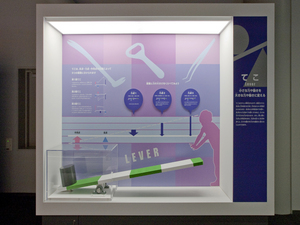Nagoya City Science Museum
TOP > Exhibition Guide > Keyword Search > Starting with "P" > Physics > Lever
Lever



Purpose of Exhibition
A lever is a hard shaped bar which can move big things using little power. If you don't use a lever, you might have to use a big machine. So, the principle of leverage plays an important role even though it is a simple principle.
This exhibition will help you understand more deeply the principle of leverage.
Additional Knowledge
[The Principle of Leverage]
To explain the principle of leverage, we define three words: the fulcrum, the point of effort, and the point of load. Each function is explained as follows; the fulcrum is to uphold the lever, the point of effort is the point at which the person applies the force, and the point of load is the point at which the weight applies the force (Figure 1).
At this time, when you put the fulcrum near the point of load, you can hold up the weight with little force than needed for the actual weight. On the contrary, when you put the fulcrum near the point of effort, you cannot uphold the weight unless you apply a big force. You have to understand the rule that the moment when centering on the fulcrum should be equally maintained both on both right and left sides.
The following principle can be explained.
(weight) x (length from the fulcrum to the point of load) = (the force applied to the objects) x (length from the fulcrum to the point of effort).
We would like you to see not only the phenomenon where objects become heavy or light by applying the lever, but also the knowledge behind the principle.
[The Types of Lever]
There are several types of lever depending on the point of the fulcrum, the point of effort and the point of load. What we explained earlier is a type of "first class lever". Apart from that, there are second class levers and third class levers. We will introduce to you these principles by using familiar objects (Figure 2).
_ First class leverA first class lever is a type of lever where the fulcrum is between the point of action and the point of effort. Nail clippers and scissors are classified as first class levers.
_ Second class leverA class second lever puts the fulcrum at the edge and is also puts both the point of effort and the point of load on the same side. If the point of effort gets closer to the fulcrum, you could apply a huge force. A bottle cap opener and hole-making tool (Hole Punch) are classified as second class levers.
_ Third class leverFirst class and second class levers are an ingenious attempt to apply a huge force. You might encounter the situation where you would like to aim for a large movement even though the force becomes small. Third class levers are for these kinds of cases.
In third class levers, the point of the fulcrum is put on the edge, and both the point of effort and the point of load are on the same side. At this time, the point of load is close to the point of fulcrum. It could be understood as a progression from the second class lever. Though it needs a large force applied to the point of the fulcrum, it transfers to a big movement (with small force) at the point of load. Chopsticks, tweezers and Japanese style scissors are classified as third class levers.
Needless to say, all classes of lever should remain steady at the moment force is applied.
Article by Koichi Mabuchi
